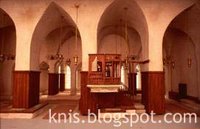

Este fue un lugar de rezo desde el siglo V, aunque la sinagoga en sí fue construida en los siglos siguientes. Como puede verse en la imagen, tenía un area al aire libre donde se hacía Tefilá durante el verano (lo cual es comun en otras sinagogas en países árabes, como la de Baghdad - tal como escribe el Ben Ish Jai). En total, con las salas aledañas, tenía 7 Hejalot. En uno de ellos era guardado el Kéter. Éste es un manuscrito del siglo X de toda la Tora, los Nebiim y Ketubim (similar al Al-Taj que se hallaba en Damasco). Fue usado por el Rambam (Maimónides), siendo que según él era la versión más correcta del texto de la Torá. Desde el siglo XV fue guardado en esta sinagoga, por lo que se lo llama el Kéter de Aram Sobá (Aram Sobá es el nombre bíbilico de esta región) o Código de Alepo, donde permaneció por unos 500 años, hasta 1947, año en que la sinagoga fue destruida e incendiada en un ataque contra los judíos, y parte de este fue dañado. Fue salvado por el Hajam Itzjak Chehebar, quien lo trajo consigo tras su partida de Siria. Lamentablemente, parte de este fue perdido en el trayecto. Hoy en día es guardado en el Museo del Libro en Israel.
Bet HaKeneseth HaGadol in Aleppo, Syria. This was a prayer place since 5th century, although the synagogue per se was built in the following centuries. As it can be seen in the image, it had an area outdoors for the praying during the summer (which is common in other synagogues in Arab countries, like the one of Baghdad - as Ben Ish Chay writes). Altogether, with the bordering rooms, had seven Hechaloth (Holly Arcs). In one of them was kept the Keter. This is a manuscript wrote in 10th century containing all the Tora, the Nebiim and Ketubim (similar to the Al-Tach kept in Damascus). It was used by the Rambam (Maimonides), being that according to him it was the most correct version of the text of the Tora. From 15th century it was kept in this synagogue, being known since then as Keter de Aram Soba (Aram Soba is the biblic name of this region) or Aleppo Codex, where it remained for about 500 years, until 1947, year in which the synagogue was destroyed and set afire in an attack against the Jews, and some parts of the Keter were damaged. It was saved by the Hacham Ischak Chehebar, who brought it with him when he left Syria. Lamentably, part of this was lost in the passage. Nowadays it is kept in the Shrine of the Book in Israel.
No hay comentarios.:
Publicar un comentario